An Extraterrestrial Message
It is the glory of God to conceal a matter, But the glory of kings is to search out a matter.
PROVERBS 25:2
10/4/202516 min read
PROVERBS 25:2 It is the glory of God to conceal a matter, But the glory of kings is to search out a matter.
God, in His infinite wisdom, often conceals truth in layers. Not everything is plainly exposed, because part of God’s majesty is that His ways are higher, His knowledge inexhaustible. If God revealed everything openly, there would be no need for faith, meditation, or relationship with Him. Concealing certain truths draws us closer, compelling us to seek Him diligently. In Scripture, God unfolds His plan progressively—prophecies in the Old Testament are shadows, later revealed in Christ.
Prayer
Heavenly Father,
We thank You that You are far greater than our understanding. Your wisdom is unsearchable, and Your ways are higher than ours. Yet You graciously reveal what we need through Your Word and by Your Spirit. Teach us to trust what You have hidden and to diligently seek what You have revealed. May our pursuit of truth draw us closer to You, and may our hearts rest in Your perfect wisdom. In Jesus’ name,
Amen.
According to Jewish tradition, God revealed to Enoch that humanity’s increasing corruption would one day bring a catastrophic judgment in the form of a worldwide flood. The prophecy was not left vague—God even tied it to the lifespan of Enoch’s son. This makes Methuselah’s birth itself a prophetic sign, a living reminder that judgment was real and coming. Enoch, in naming his son, was in effect preaching a message every time Methuselah’s name was spoken: “When he dies, it shall be sent.” Thus, Enoch’s prophetic witness was not just in words, but woven into history through his family.
Methuselah lived 969 years, the longest lifespan recorded in the Bible. His longevity is no coincidence. It reveals God’s extraordinary patience. The longer Methuselah lived,
THE FLOOD
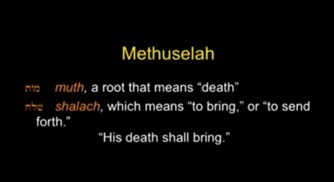

the longer humanity had to repent. His life became a measure of divine mercy. Each year was another year of reprieve. His death coincided with the year of the Flood, showing that God’s warning through his name was literally fulfilled. In this way, Methuselah became a living countdown clock of God’s mercy and eventual justice. Methuselah’s long life embodies this truth. God’s heart was not eager to destroy, but to save. Judgment was delayed to the utmost limit.
THE GENEALOGY OF NOAH
God’s plan of redemption is woven into the very fabric of human history, and even hidden within the genealogies themselves. The genealogy from Adam to Noah in Genesis 5 often looks to us like just a list of names, but Jewish and Christian commentators alike have seen layers of meaning tucked away there. The Hebrew names themselves tell a story—almost like a sentence that summarizes the Gospel. When read together, the genealogy whispers a prophecy: “Man [is] appointed mortal sorrow; but the Blessed God shall come down, teaching that His death shall bring the despairing comfort and rest.”
This means Calvary was not “Plan B.” The cross wasn’t God’s patchwork solution after Adam’s failure—it was His eternal design, the ultimate revelation of His love and justice.
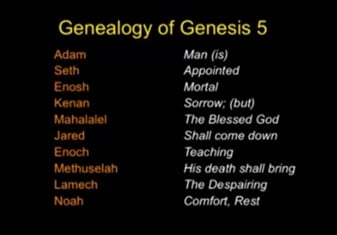

God is sovereign; He could have prevented Adam and Eve from sinning. But in His infinite wisdom, He allowed the fall so that His grace could be displayed in redeeming the unworthy, His mercy could be revealed in sparing the guilty, and His love could shine brightest against the backdrop of human rebellion. The fall provided the stage on which redemption could unfold, displaying facets of God’s character that creation alone could never fully reveal.
The genealogy to Noah is not just history—it’s theology in code. It shows us that God’s redemptive story was already in motion. Every step, every name, every lifespan was guided by God’s sovereign hand, leading toward the Messiah.
EPHESIANS 1:4 just as He chose us in Him before the foundation of the world, that we would be holy and blameless before Him. In love
THE BIBLE
“The New Testament is in the Old concealed; the Old is in the New revealed.” The Bible is not two disconnected books, but one story with two parts. The Old Testament lays the foundation: creation, fall, covenant, sacrifice, prophecy. But much of it is veiled in types, shadows, and symbols. The New Testament unveils the mystery: Christ is revealed as the fulfillment of every shadow and promise.
In the Old Testament, we see Christ concealed. The ark that saves from judgment prefigures Him. The Passover lamb points to His sacrifice. The tabernacle and temple foreshadow His presence. The prophets speak of Him in glimpses and riddles.
In the New Testament, we see Christ revealed. He is the true Ark, the true Lamb, the true Temple, the One whom all the prophets pointed to.
In the Book of Genesis, an intriguing pattern emerges. Starting at a specific point and counting forward every 49th letter, the sequence reveals a T. Continuing in the same way, the next 49th letter is an O, followed by an R, and then an H. Together, these letters spell TORH—the consonants of the word Torah.
In the Book of Exodus, this same intriguing pattern is found. Starting at a specific point in the Hebrew text and counting forward every 49th letter, the sequence unfolds: first a T, then an O, followed by an R, and finally an H. Together, these letters spell TORH—the consonants of the word Torah.
In the Book of Leviticus, however, the 49-letter sequence spelling Torah does not appear.
THE TORAH CODES
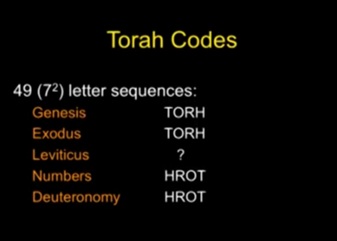

In the Book of Numbers, another fascinating pattern emerges. Beginning at a certain point and counting forward every 49th letter, the sequence spells H–R–O–T—the word Torah written in reverse.
In the Book of Deuteronomy, this same pattern is repeated. Starting at a specific point in the Hebrew text and counting every 49th letter, the sequence once again unfolds in reverse: H–R–O–T—Torah spelled backward.
In the Book of Leviticus, the pattern changes. Instead of forming the word Torah through a 49-letter sequence, the text unveils something even more profound. By counting every 7th letter, the sequence spells YHWH—the sacred Name of God.
Together, these patterns form a remarkable design: Genesis and Exodus spell Torah forward, as if pointing toward the center. Numbers and Deuteronomy spell Torah backward, as if pointing back toward the center. And at the center stands Leviticus, the book focused on God’s holiness, His sanctuary, and His presence among His people.
It’s as if the outer books are pointing toward the center, where God’s Name is revealed—a divine reminder that all Scripture leads us to the presence of the Lord Himself.
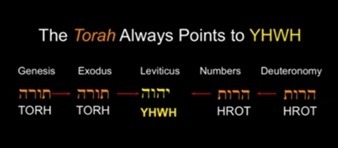

At first glance, Genesis 38 seems like a strange interruption in the flow of Joseph’s story. Chapter 37 ends with Joseph being sold into slavery, and Chapter 39 resumes his time in Egypt. Suddenly, we’re presented with the story of Judah, Tamar, and the birth of twins — Perez and Zerah. Many readers treat this chapter as a side story, but it is actually a crucial link in the Messianic chain. God intentionally placed it here, both narratively and prophetically, to show that His covenant promises continue even in the midst of human sin and failure.
Scholars and students of the Torah Codes have noted that, at 49-letter intervals (7×7) in Genesis 38, the names appear in this astonishing order:
Boaz → Ruth → Obed → Yishay (Jesse) → David
This sequence outlines the royal lineage that would come centuries later — from Ruth and Boaz to King David, the ancestor of the Messiah. Whether one interprets this as coincidence or divine design, the message is unmistakable: God’s plan of redemption was encoded into Scripture from the very beginning. Before David ever lived, his lineage was already “written” into the inspired text — a reflection of God’s omniscience and sovereign foreknowledge.
The story centers on Judah and Tamar, and through their union comes Perez, the ancestor of David. This means that even through moral failure, deceit, and human weakness, God’s redemptive plan was still at work.
Judah sinned, but God brought forth grace.
Tamar was wronged, but God brought forth justice.
Out of brokenness came the lineage of kings — and ultimately, the Messiah Himself.
The number 49 is significant in Scripture — it represents completeness and divine perfection (the Sabbath cycle, the Jubilee). That these names appear at 49-letter intervals subtly reinforces the theme of God’s perfect timing and complete sovereignty. Every generation, every person, every choice was woven into His plan of redemption long before human eyes could see it.
GENESIS 38
NEW BEGINNING
GENESIS 8:4 Then in the seventh month, on the seventeenth day of the month, the ark rested upon the mountains of Ararat.
The word “rested” is key — it is the first mention of rest after judgment. The Ark, which carried Noah and his family through the flood (a symbol of divine judgment), came to rest on that day. This marks the end of God’s wrath and the beginning of new life on earth.
The Ark represents Christ, who carries all who believe in Him safely through the waters of judgment. When the Ark rested, it signifies peace after wrath, salvation after destruction, and life after death — a beautiful picture of redemption.
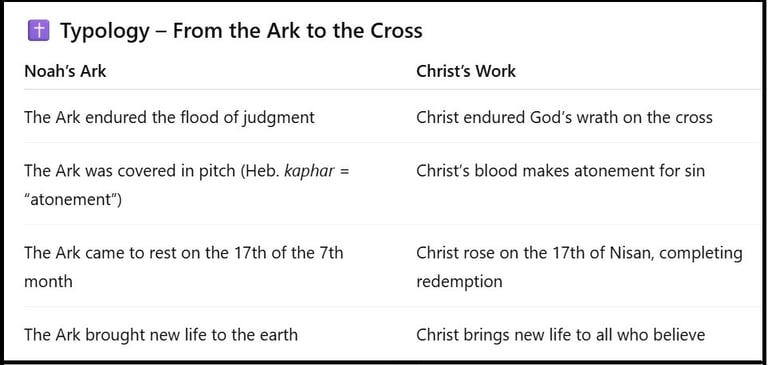

The 17th Day of the 7th Month is one of the most striking hidden patterns in Scripture. According to the Jewish calendar after the Exodus, the seventh month (Nisan) became the first month of the religious year. That means:
The 14th of Nisan → Passover (the day the Lamb was slain).
The 17th of Nisan → Three days later — the Resurrection of Christ!
So the Ark rested — a picture of salvation complete — on the same date that Jesus rose from the dead thousands of years later!
The Ark came to rest on the mountains of Ararat — resurrection ground. Christ rose on that same calendar day — resurrection life. Coincidence? Not at all. It’s divine design.
“Ararat” likely comes from the root word meaning “the curse reversed.” After the flood — after judgment — the Ark rested where the curse was undone. That perfectly aligns with what Christ accomplished on the cross: “Christ redeemed us from the curse of the law…” Thus, Ararat becomes a symbol of redemption — the place where God brings man out from judgment and curse into grace and new creation.
THE BRAZEN SERPENT
NUMBERS 21:5 The people spoke against God and Moses, “Why have you brought us up out of Egypt to die in the wilderness? For there is no food and no water, and we loathe this miserable food.” 6 The Lord sent fiery serpents among the people and they bit the people, so that many people of Israel died. 7 So the people came to Moses and said, “We have sinned, because we have spoken against the Lord and you; intercede with the Lord, that He may remove the serpents from us.” And Moses interceded for the people. 8 Then the Lord said to Moses, “Make a fiery serpent, and set it on a standard; and it shall come about, that everyone who is bitten, when he looks at it, he will live.” 9 And Moses made a bronze serpent and set it on the standard; and it came about, that if a serpent bit any man, when he looked to the bronze serpent, he lived.
The Israelites, weary from the wilderness journey, complained against God and Moses — rejecting the very provision (manna) that sustained them. Their grumbling revealed ingratitude and unbelief, a heart that looked back to Egypt rather than forward to God’s promise.
The fiery serpents (likely venomous snakes whose bites caused burning pain) were sent as divine judgment — a reflection of sin’s deadly sting.
The bronze serpent lifted on a pole became the means of healing: those who looked at it in faith were miraculously healed. Thus, the bronze serpent symbolized both judgment and mercy — judgment because it represented the cause of their suffering (the serpent), and mercy because God provided a way to be healed.
The serpent is a symbol of sin and the curse. Yet God commanded Moses to make a likeness of the serpent — not a real one — and lift it up. Likewise, Jesus was made “in the likeness of sinful flesh” — though He was without sin.
The bronze serpent was lifted up on a pole for all to see. The “lifting up” refers to the crucifixion — where Christ bore the curse of sin on our behalf.
The Israelites were not told to work, sacrifice, or perform rituals — only to look at the bronze serpent in faith. Similarly, salvation comes not by works, but by faith alone in the crucified Christ.
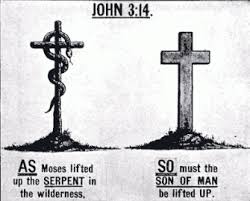

2 KINGS 18:3 He (King Hezekiah) did right in the sight of the Lord, according to all that his father David had done. 4 He removed the high places and broke down the sacred pillars and cut down the Asherah. He also broke in pieces the bronze serpent that Moses had made, for until those days the sons of Israel burned incense to it; and it was called Nehushtan.
Symbols of faith can become objects of idolatry if the heart turns from God to the object itself. Over the centuries, the bronze serpent became an object of veneration. This reveals how even good, holy things — traditions, symbols, religious artifacts, even spiritual experiences — can become idols when they replace our direct relationship with God. The people began burning incense to it — treating it as if it had power in itself, rather than seeing it as a symbol pointing to God’s mercy.
King Hezekiah was one of Judah’s most righteous kings. He Removed the high places (sites of unauthorized worship). He Broke down sacred pillars and Asherah poles (used for pagan rituals). And he crucially, destroyed the bronze serpent that Moses had made centuries earlier.
1 CORINTHIANS 10:11 Now these things happened to them as an example, and they were written for our instruction, upon whom the ends of the ages have come.
The events recorded in the Old Testament—especially Israel’s failures and God’s discipline—were not merely historical stories but intentional lessons from God for future generations. God allowed their experiences to serve as warnings and reminders for us so we will not repeat the same sins of idolatry, disobedience, and unbelief. Scripture is meant to teach, guide, and protect believers by showing both the consequences of sin and the faithfulness of God. Christians now live in the final stage of God’s redemptive plan—after the coming of Christ and before His return—making us even more accountable to obey God’s Word. I
JOHN 3:14 As Moses lifted up the serpent in the wilderness, even so must the Son of Man be lifted up; 15 so that whoever believes will in Him have eternal life.
The “lifting up” refers to His crucifixion on the cross — being physically lifted up, and spiritually exalted as Savior. Just as the Israelites had to look at the bronze serpent to be healed, so we must look to Jesus in faith to be saved. Salvation is not earned by works, rituals, or religion, but received through faith in the crucified Christ.
2 CORINTHIANS 5:21 He made Him who knew no sin to be sin on our behalf, so that we might become the righteousness of God in Him.
This doesn’t mean Jesus became sinful, but that He took upon Himself the full weight, guilt, and penalty of our sin. He became the sin offering, standing in our place under God’s righteous judgment.
THE CAMP OF ISRAEL
The Camp of Israel is rich with symbolic and prophetic meaning—every detail God gave to Moses in the wilderness carries a spiritual truth that points to Christ and God’s redemptive plan.
God gives the detailed instructions about how the twelve tribes of Israel were to camp around the Tabernacle in the wilderness.
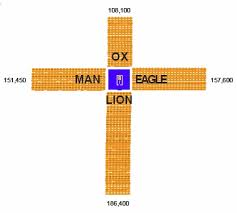

The Tabernacle stood at the center — the dwelling place of God’s presence.
Around it were the Levites, responsible for its care.
The twelve tribes were arranged in four groups, three on each side:
East: Judah, Issachar, Zebulun
South: Reuben, Simeon, Gad
West: Ephraim, Manasseh, Benjamin
North: Dan, Asher, Naphtali
Each group camped under its standard (banner) with the name of their leading tribe.
Each camp’s banner had a symbol:
Judah (East): a lion
Reuben (South): a man
Ephraim (West): an ox
Dan (North): an eagle
The Tabernacle was in the middle of the camp—this shows that God was to be the center of Israel’s life, their worship, and their identity. This points to how Christ dwells in the midst of His people, and how believers’ lives should revolve around Him.
When the tribes are arranged, the camp’s formation from above forms the shape of a cross:
Judah’s camp (east) was the largest, forming the longest arm.
Ephraim’s (west) was smaller.
Reuben (south) and Dan (north) were balanced in number.
So, if viewed from above, the Camp of Israel formed a cross with the Tabernacle (God’s dwelling) at the intersection. Even in the wilderness, God’s people were camped around the symbol of redemption—the cross of Christ.
THE GOSPEL
The four Gospels are not four conflicting stories, but four complementary portraits of one Person: Jesus Christ. Each Gospel was divinely designed with a specific purpose and audience, revealing a different aspect of His glory and mission.
1. Matthew — Jesus the King of the Jews
Audience: Primarily Jewish
Theme: Jesus the Messiah, the promised King
Symbol: 🦁 Lion — the royal beast, symbolizing kingship and authority
Key Verse:
“This is Jesus, the King of the Jews.” — Matthew 27:37
Design:
Matthew opens with a genealogy proving Jesus’ royal lineage from Abraham and David. It presents Jesus as the fulfillment of Old Testament prophecy — the King who brings the Kingdom of Heaven. It emphasizes His teaching authority and His role as the long-awaited Messiah.
Focus: The Sovereignty of Christ.
2. Mark — Jesus the Servant of God
Audience: Roman believers
Theme: Jesus the humble Servant who came to serve and to save
Symbol: 🐂 Ox — symbol of service and sacrifice
Key Verse:
“For even the Son of Man did not come to be served, but to serve, and to give His life a ransom for many.” — Mark 10:45
Design:
Mark portrays Jesus in constant action — working miracles, serving people, and laying down His life. There’s no genealogy here because servants don’t need one. It’s the Gospel of action and power, showing that true greatness comes through humble service.
Focus: The Humility and Ministry of Christ.
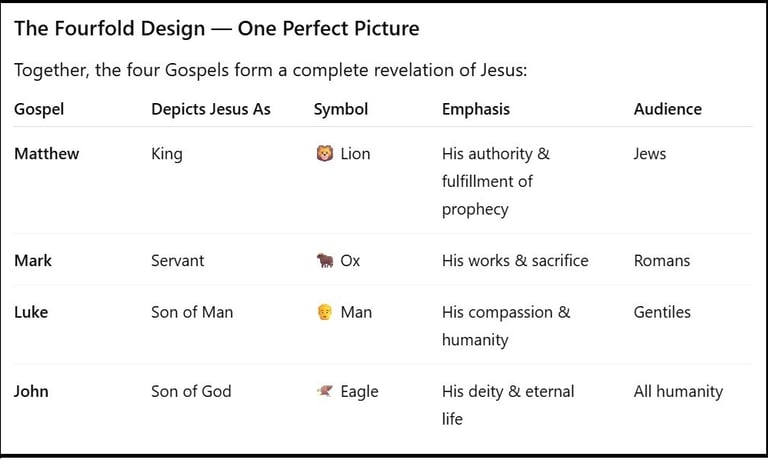

3. Luke — Jesus the Son of Man
Audience: Gentiles (non-Jews)
Theme: Jesus the perfect Man, full of compassion and humanity
Symbol: 👨 Man — representing His full humanity
Key Verse:
“For the Son of Man came to seek and to save the lost.” — Luke 19:10
Design:
Luke, a physician and historian, gives a detailed, orderly account of Jesus’ life. He traces His genealogy all the way back to Adam, showing that Christ came for all humanity. Luke highlights Jesus’ compassion for the poor, sinners, women, and outcasts.
Focus: The Compassion and Humanity of Christ.
4. John — Jesus the Son of God
Audience: The whole world
Theme: Jesus the eternal Word, God in the flesh
Symbol: 🦅 Eagle — soaring high, representing divinity and heavenly vision
Key Verse:
“These are written that you may believe that Jesus is the Christ, the Son of God, and that by believing you may have life in His name.” — John 20:31
Design:
John reveals the divine nature of Jesus — “In the beginning was the Word, and the Word was with God, and the Word was God.” (John 1:1)
It focuses on belief, eternal life, and the revelation of God’s love through His Son.
Focus: The Deity and Glory of Christ.
The Gospels are not merely biographies; they are divine revelations of the one Savior in four dimensions — King, Servant, Man, and God. Together they form the complete portrait of Jesus Christ, the fullness of God revealed in human form.
THE TECHNOLOGY
The Bible doesn’t mention “technology” by name, but it foretells the conditions, capabilities, and global systems that modern technology would make possible. It shows that God knew from the beginning where human progress would lead — and how it would set the stage for prophetic fulfillment.
1. Knowledge and Travel Increase
Daniel 12:4 “But you, Daniel, shut up the words, and seal the book until the time of the end; many shall run to and fro, and knowledge shall increase.”
🔹 Interpretation:
Daniel foresaw a time when global travel (“run to and fro”) and explosive knowledge would define human civilization. Today, with airplanes, cars, the internet, and AI, we see this fulfilled. Knowledge doubles faster than ever—some say every few months.
2. Global Communication
Revelation 11:9–10 “For three and a half days some from the peoples and tribes and languages and nations will gaze at their dead bodies...”
🔹 Interpretation:
This refers to the Two Witnesses in Revelation. It says people from all nations will see them — something impossible before satellite TV, live streaming, and global internet. Now, anyone anywhere can witness global events instantly.
3. Cashless Economy and Mark of the Beast
Revelation 13:16–17 “He causes all, both small and great, rich and poor, free and slave, to receive a mark... and that no one may buy or sell except one who has the mark…”
🔹 Interpretation:
This points to a digital economic system — one where transactions are controlled electronically. Today, we see the rise of digital currencies, biometric IDs, implants, and AI-powered economic systems, making this prophecy increasingly plausible.
4. Weapons of Mass Destruction
Zechariah 14:12 “Their flesh shall dissolve while they stand on their feet, their eyes shall dissolve in their sockets, and their tongues shall dissolve in their mouths.”
🔹 Interpretation:
This sounds eerily like a nuclear explosion or advanced weaponry — heat so intense that it instantly disintegrates flesh. Zechariah saw an event that could only be explained by modern weapons technology.
5. The Image that Speaks
Revelation 13:14–15 “He was granted power to give breath to the image of the beast, that the image... should both speak and cause as many as would not worship the image... to be killed.”
🔹 Interpretation:
An image that speaks and exercises control could resemble AI, holograms, or virtual intelligence—machines capable of speech and influence.
Artificial intelligence that enforces loyalty or controls populations mirrors this prophecy remarkably well.
6. Global Connectivity and Instant Information
Matthew 24:14 “And this gospel of the kingdom will be preached in all the world as a witness to all the nations, and then the end will come.”
🔹 Interpretation:
The Gospel could not be preached to “all nations” until the age of satellite communication, the internet, and digital Bibles. Technology now makes this prophecy possible in real time.
7. Fire from Heaven
Revelation 13:13 “He performs great signs, so that he even makes fire come down from heaven on the earth in the sight of men.”
🔹 Interpretation:
This could symbolize laser technology, missile warfare, or even directed energy weapons—technologies that literally bring fire from the sky.
Prayer:
Lord Jesus,
we thank You for becoming the remedy for our sin. When we were poisoned by rebellion, You were lifted up to bring healing and life.
Turn our eyes away from ourselves and fix them upon You — the source of our salvation and the anchor of our souls.
Lord God, we praise You that in Christ, we find rest after every storm. Through His death and resurrection, the curse is broken, the power of sin is defeated, and new life has begun. Teach us to rest in Your finished work, to trust You through every flood and trial, and to walk daily in the newness of life You have freely given.
May our hearts remain lifted to You, our Healer and Redeemer, until the day we behold You face to face.
In Jesus’ mighty name,
Amen.
Knowing God - An Extraterrestrial Message
The content of this article is adapted from the source below:

Contact
Get in touch for more insights.
Follow
Subscribe
info@themessageofgod.Some
123-456-7890
© 2025. All rights reserved.
By God’s grace, this website was created to share His Word, encourage others in their faith, and lead people to a personal relationship with Jesus Christ. God has uniquely designed and equipped every believer to take part in His work, and this website is one small expression of that calling.
All glory, honor, and praise belong to God alone. I am deeply grateful to Christ’s Commission Fellowship (CCF)—God’s instrument in helping me know Jesus personally and grow in a deeper, more intimate relationship with Him. The messages shared here are inspired by past CCF sermons, which have greatly influenced my walk with the Lord.
The ultimate purpose of this website is to point people to Jesus, encourage them to follow Him wholeheartedly, and remind every reader that a life surrendered to Christ is a life filled with purpose, grace, and joy.
